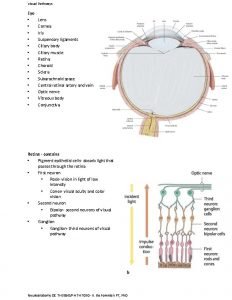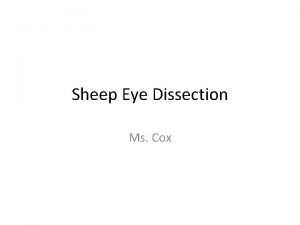REINFORCEMENT OF SUSPENSORY LIGAMENTS UNDER LOCAL ANESTHESIA CURES

- Slides: 1

REINFORCEMENT OF SUSPENSORY LIGAMENTS UNDER LOCAL ANESTHESIA CURES PELVIC ORGAN PROLAPSE-36 MONTH RESULTS. ○SEKIGUCHI Y, NAKAMURA A, MAEDA Y, FUJISAKI A, ENOMOTO K, YAO M Women’s Clinic LUNA Group , LUNA Pelvic Floor Total Support Clinic JAPAN Hypothesis / aims of study The TFS (Tissue Fixation System) is a “minisling device for stress urinary incontinence and pelvic organ prolapse reported in 2005. It was developed by Prof. Petros who has proposed “ Integral Theory”. 1) It is made two polypropylene plastic anchors attached to an adjustable non-stretch 7 mm monofilament polyprolylene mesh tape. The TFS consists of the 4 pronged anchor, its mode of action which is like a grappling hook, and the one-way tensioning system. This has the unique quality of restoring laterally displaced ligaments and fascia to the correct anatomical position. The TFS is applied entirely from the vagina, and so it does not require perforation of suprapubic, or perineal skin. Like the TVT(Tension Free Vaginal Tape), the TFS works by creating a foreign body collagenous tissue reaction which reinforces weakened pelvic ligaments. This procedure can be done day surgery basis. We reported 12 months results to assess the effectiveness, perioperative safety and degree of minimary invasion of the TFS for repair of pelvic organ prolapse (POP) already. 2) In 2009, material of TFS tape changed from type 3 to type 1 mono-filament non-stretch polypropylene. We report 36 months results by 2 nd Generation of The TFS this time. (Fig 1). Patients and Methods We prospectively studied 127 patients, mean age 67± 7. 8, between May 2009 and December 2012 at Women’s Clinic LUNA. Mean BMI was 22. 7± 3. 0 and parity 2. 4(1 -4). Levels of POP were grade Ⅱ (n=35) (28%), grade Ⅲ (n=88) (69%), and grade Ⅳ (n=4) (3%) according to the ICS POPQ classification as follows. [ 0: No prolapse is demonstrated during maximal straining, I: The most distal portion (leading surface) of the prolapse is > 1 cm above the level of the hymen ( < - 1 cm), II : The most distal portion (leading edge)of the prolapse is ≤ 1 cm proximal to or extends 1 cm through the plane of hymen ( ≥ - 1 cm, but ≤ + 1 cm), III: The most distal portion of the prolapse is > 1 cm below hymen but no further than 2 cm less than the TVL (there is not complete vaginal eversion). ( > +1 cm, but < + [ TVL-2] cm), IV: Complete eversion of the vagina ( ≥ + [TVL -2] cm )] Patients were given hydroxyzine hydrocholoride 25 mg and atropine sulfate 0. 5 mg i. m. and diclofenac sodium 50 mg p. r. before operation. The operations were performed under local anesthesia (LA) by two surgeons, using 1% xylocaine 40 ml + physiologic saline 160 ml + vasopressin 40 units. Patients were additionally given midazolam 5 mg intravenously. First the uterosacral ligament (USL) TFS sling operation was performed. (Fig 2) We then did a cervical ring TFS sling for restoration of the cardinal ligament/cervical ring defect (also known as the “transverse defect”). (Fig 3) Finally we performed the U-sling operation for paravaginal repair. The surgical principle underpinning this operation is to reinforce the ATFP, re-attach the pubocervical fascia to the ATFP, and to provide a transverse neofascial ‘beam’ to reinforce the damaged central pubocervical fascial defect. (Fig 4) This study was approved by the Ethics Committees of the Yokohama Motomachi Women’s Clinic LUNA in 2006. Written informed consent was obtained from all patients. . Follow up was performed at 36 months. We defined surgical failure as above Grade Ⅱaccording to the ICS POPQ classification. We used Prolapse Quality of Life (P-QOL) questions for QOL measurement. Table 1: Operating data Results: 98%(125/127) of patients were discharged on the same day as the surgery. The average number of tapes which were used person was 2. 5. ( Median 3, Maximum 4, Minimum 1) Operating data are in Table 1. Complication data are in Table 2. One patient with a hematoma was transferred to a neighbouring hospital for observation Table 2: Complication data purposes only. We found no case of erosion in tape insertions. 113 patients(88%) could be followed up on 36 months. 106 cases(93%) were successful and 7 cases(6%) failed. 5 cases in the 7 failed cases were cured by reoperation within 36 months. There were 6 cases( 5%)who complained bulging of another parts and were given additional tape grafting. The total number of patients who had no surgical failures and no additional operation for POP was 100 (89%). (Fig 5) Fig 5: Results on 36 months Discussion : The TFS is a tensioned system. It restores the anatomy of pelvic ligaments and fascias to their former condition, thereby restoring not only organ support, but function, as regards the control of urination and defecation. USL TFS sling has a risk of ileus and Cervical TFS sling has a risk of injury to uterine artery. Therefore We are doing enough liquid separation before applying TFS now. The erosion rate of 2 nd Generation of TFS is 0%. It contributes to minimum invasive surgery. Conclusions: The TFS uses the same surgical principle for repair as the TVT: This principle vastly minimizes volume of mesh used, erosions and other complications. Failure 7 pt(6%) Additional op. 6 pt. (5%) Success 100/113(89%) References: 1)Petros PE:The Female Pelvic Floor Funcion. Dysfunction and Management According to the Integral Theory Third Edition Springer 2010 2)SEKIGUCHI Y, KINJYO M, MAEDA Y, KUBAOTA Y: REINFORCEMENT OF SUSPENSORY LIGAMENTS UNDER LOCAL ANESTHESIA CURES PELVIC ORGAN PROLAPSE-12 MONTH RESULTS. Int Urogynecol J (2014) 25: 783– 789

